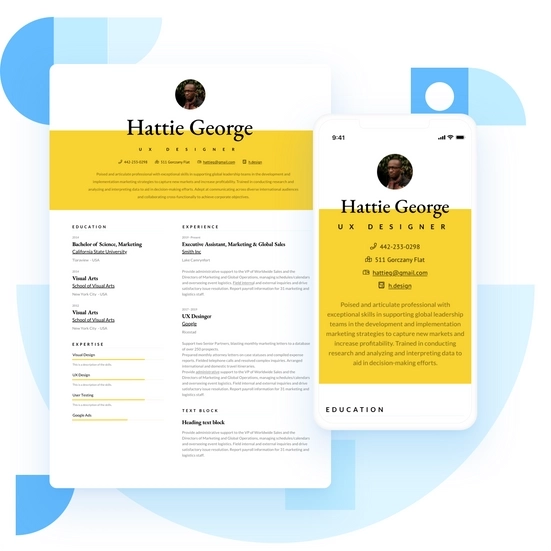
Professional Resume Formats for 2025 | Resume Format Examples for All Jobs

Is your resume format good enough?
Let’s do a litmus test.
Spend 5 seconds trying to find relevant information from your resume.
Were you impressed by what you see?
Chances are, you aren’t! In this article, we are going to show you how to properly format your resume, including the use of combination resumes.
In this article, you will find:
- 3 popular Resume format examples
- How to select the right resume format.
- Resume formatting tips by different experience levels
- How to format your resume to land more interviews
Understanding Resume Formats
A resume format is the way a resume is organized and structured to showcase a job applicant’s qualifications, skills, and experience. There are several types of resume formats, each with its own strengths and weaknesses. Understanding the different types of resume formats can help job seekers choose the best format for their needs and increase their chances of getting hired.
Why Resume Format is Important?
The right resume format makes it easier for a hiring manager to assess your skills and past experience. If they are unable to find relevant information, chances are that your resume is more likely to be rejected.
A common reason for not hearing back after applying to dozens of job postings is a bad resume format, as employers prefer resume formats that clearly showcase qualifications and relevant experiences. That’s why it is important that you select the right format and follow our resume formatting suggestions provided below.
How to Format a Professional Resume?
To format your resume, follow these steps:
- Select the right format from the most popular resume formats.
- Avoid 0.5 inches or fewer margins. A 1-inch margin is preferable, it also allows the hiring manager to hold your resume without repositioning fingers.
- Keep font size to 12 pt so that it is easy to read.
- Add contact information clearly in the header section, a short summary below the resume header, a work history section with a bullet list, and certifications/skills/education in a section of their own.
- Use fonts like Times New Roman, Roboto, etc that are more eligible. Avoid using fonts like Comic Sans. Evaluate your fonts on their readability at the end.
- Check your country-specific best practices when it comes to adding a photo to your resume.
- Unless you have 15+ years of experience, keep your resume to one page.
- Avoid adding full address. Instead follow the format of city, state.
- Keep your interview relevant to the job that you are applying for by keeping it consistent.
- While listing personal projects only add those in the order of complexity and/or scale.
- Leave out sections that aren’t relevant to the job.
- No paragraph (summary, project description, etc) should be more than two lines.
- Avoid adding references unless your job ads ask for them.
- Add keywords to make sure your resume is formatted well for ATS.
Choosing the Best Resume Format
Choosing the best resume format depends on the job applicant’s career stage, work history, and the type of job they are applying for. For example, a chronological resume format is best for experienced job seekers with a strong work history, while a functional resume format is best for first-time job seekers or those changing careers. A combination resume format is best for those with a mix of work experience and skills.
Resume Formatting Checklist
To ensure your resume’s formatting is consistent, try the following:
- Use a maximum of two different fonts. More than three fonts in the same resume would make it look unprofessional.
- If you wish to add colors, make sure to use a maximum of two colors to differentiate sections and text. You can also mark certain text in bold, but make sure not to overdo it.
- Keep your margins and padding consistent.
- The minimum font size should be 11 pt.
- Keeps dates in a consistent format.
- List sections in the order of importance to the hiring manager.
- If you have less than 15 years of experience, your resume should be one page. Else, more than two pages are acceptable.
Resume Formatting Checklist to Show Relevance to the Target Job
- If your work experience is relevant to the job, use a reverse chronological resume format.
- If your work isn’t very relevant to the job, use either a combination or a functional resume format.
- Look at the job description and add or remove sections or text to make sure your resume is formatted to mirror it.
- Finally, use keywords from the job description to become even more relevant to the job.
How to Format a Creative Resume?
To format a creative resume, you should:
- Make sure the colors are right. Don’t use colors that don’t fit well together.
- While adding sections make sure there’s a clear hierarchy and consistency to guide the hiring managers to the most important information.
- While creating a creative resume summary, ensure that it is not more than 3 lines in length.
- Be creative while listing your skills, use metaphors or symbols to show your skills. Make sure they are easy to read.
- Always test your final creative resume with friends/colleagues/mentors and collect their thoughts. Leveraging feedback in shaping a creative resume’s formatting is very important.
Three Popular Resume Formats (with Examples)
The top three popular resume formats for 2025 are:
- Reverse chronological resume format
- Functional resume format
- Combination resume format
Reverse Chronological Resume Format Example
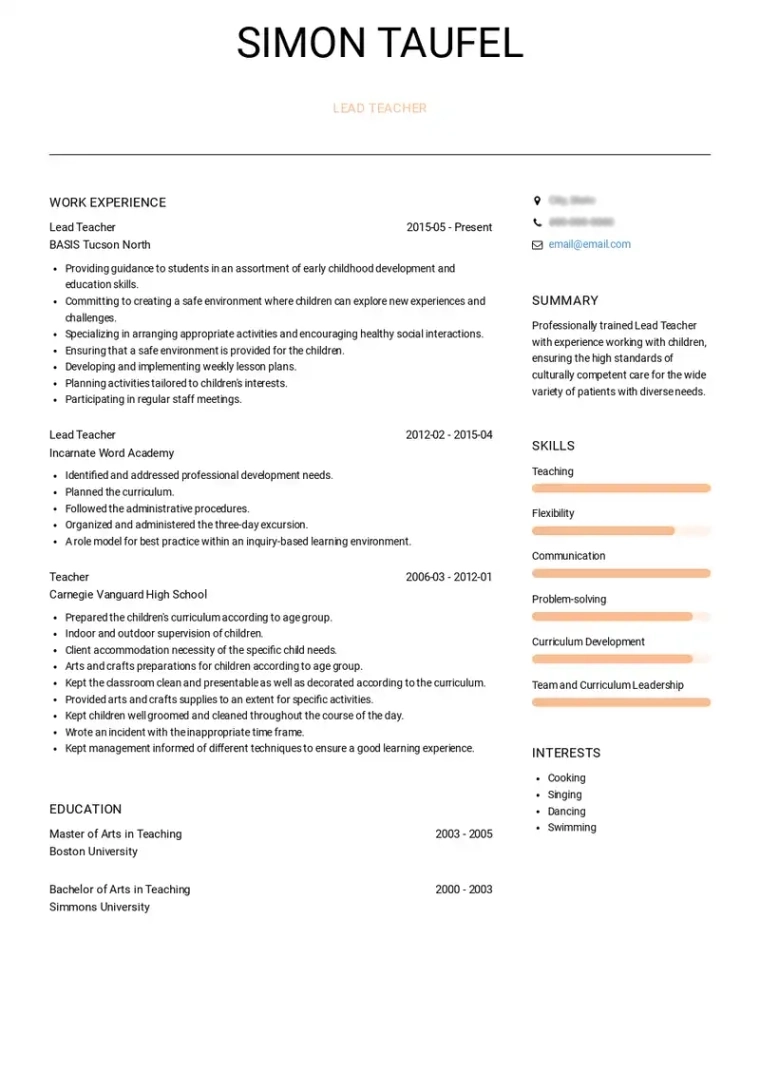
Functional Resume Format Example
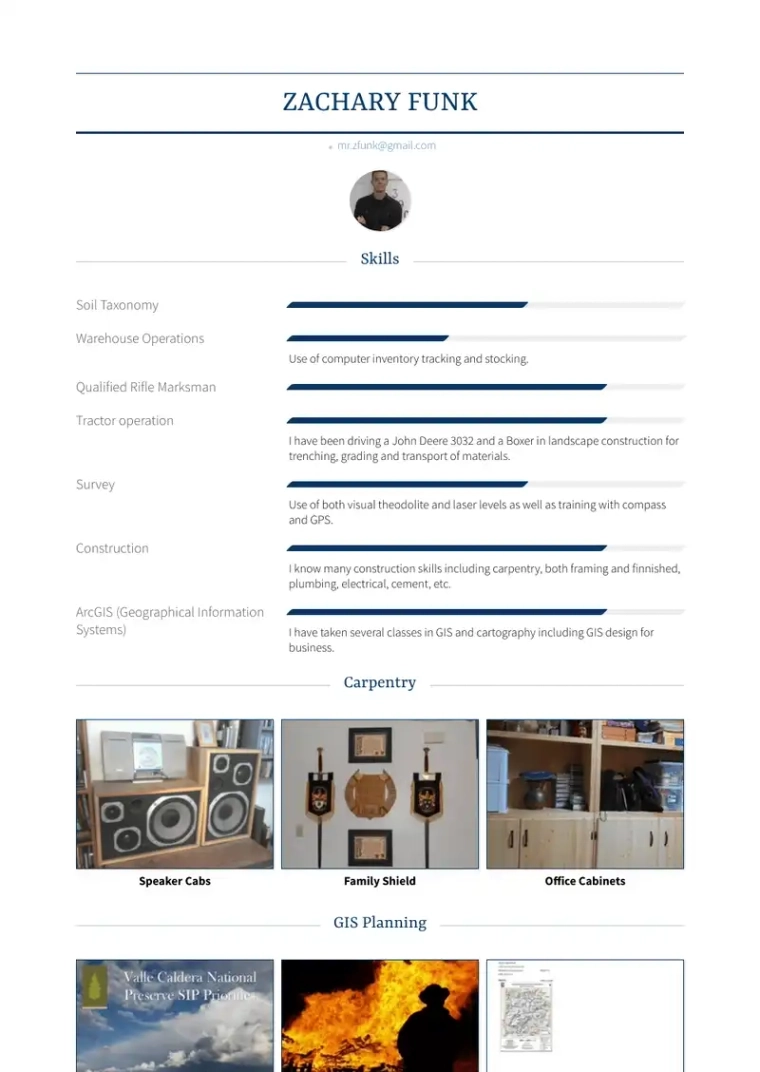
Combination Resume Format Example
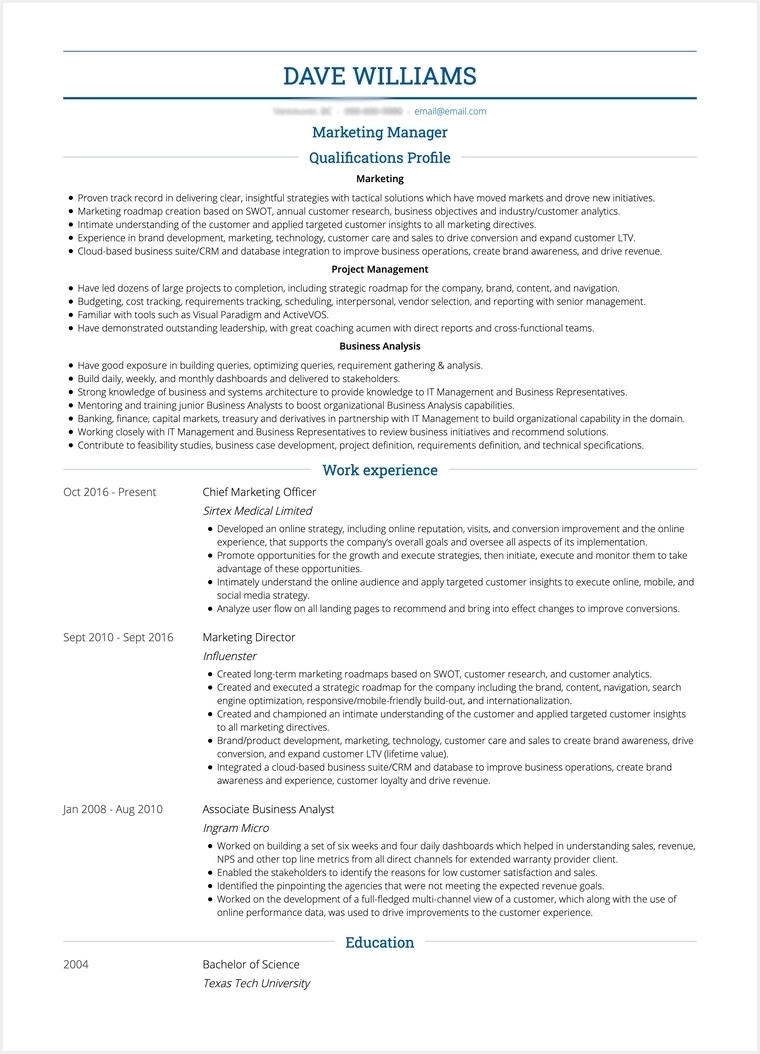
2024 Resume Format Trends We Observed So Far
In 2024, resume formats are evolving and we have observed the following:
- Visual & Video Resumes: Job seekers utilize visual elements like infographics and video platforms to creatively showcase skills and experiences.
- ATS-Friendly Formats: Standard fonts, simple layouts, and relevant keywords are prioritized for easy parsing by Applicant Tracking Systems (ATS).
- Hybrid & Customized Resumes: Hybrid formats blend chronological and functional structures, while customization tailors resumes to specific job roles and industries.
- Online Portfolio Integration: Resumes include links to online portfolios, websites, and LinkedIn profiles, providing additional context for recruiters.
- Mobile Optimization: Responsive design and concise formatting ensure resumes are easily accessible and legible on smartphones and tablets, reflecting the rise of mobile recruitment.
- Soft Skills Emphasis: Communication, adaptability, problem-solving, and emotional intelligence are highlighted alongside technical skills, demonstrating overall fit for roles.
How to Format a Reverse Chronological Resume?
To format a reverse chronological resume, follow these steps:
- Fit 10-15 years of experience on one page.
- Aesthetically, you can add a maximum of 5 job titles on one page before it starts to appear poorly formatted.
- If you have significant achievements, create an achievements section over a project section.
- Try to show all skills listed within your work history or achievements section. Saying “I'm skilled at X” won't help your application if you can't show it.
- If you have two or more work experiences that overlap e.g. job title 1, Oct 22 - Present and job title 2, Dec 22 - Feb 23. Job title 2 should be placed above job title 1 in this case.
- If you have three jobs with dates e.g. July 2021 - May 2022, Oct 2021 - May 2022, and April 2021 - May 2022 - format them by start date. April 2021 will come at the top in this case.
- Avoid adding any additional information that would reduce relevance to the job. E.g. applying for a software engineering position and listing a mechanical engineering degree would reduce relevance.
How to Format a Functional Resume?
To format a functional resume, follow these steps:
- Add your full name, city, country, and current job title in the header section.
- Write a summary, skills, past work experience, certifications, project work, and education to support career transition.
- Format your work history by listing start and end dates, company name, job title, and responsibilities following the STAR method.
- While formatting your education section, only add details if you are an entry-level candidate. Else, keep it short.
- The right format for the education section for an entry-level candidate should include course name, start-end date, GPA (if it is more than 3.6), awards (e.g. Dean's list), and more details if it is relevant to the job.
- Make sure you are only adding relevant skills to the resume. Otherwise, your resume won't be in the right format and appear cluttered.
- Provide more contextual information to a hiring manager by creating individual sections for certifications, languages, etc.
- Format your resume summary/objective to show how your skills and past experience is relevant to the role.
How to Format a Combination Resume?
To professionally format a combination resume, follow these steps:
- Format header by adding: full name, email, phone number, and portfolio links. Keep it short.
- Your summary/objective format would be a bit different. Instead of it being a short paragraph, it will be a bulleted list of skills based statements. (e.g. Won PMI OCDP 2023 Award for doing X).
- Format your work experience by listing your most relevant, recent work experience first. Follow a reverse chronological order while listing throughout your resume.
- Create a skills section and only list skills that are relevant to the position. To best format your education section, make sure your education is at the end of the resume. Add a very high-level overview of your educational background.
- Litmus test your resume format - see if you can find the most relevant information in less than 5 seconds. If you do, your resume formatting is good.
How to Format a Messy Resume?
To format a messy resume, follow these steps:
- Use a visually clean resume template and fill relevant sections.
- If you have paragraphs describing your work experience for each position - turn them into bullet lists instead.
- Move sections around till you feel the visual hierarchy is perfect.
- For non-Arabic resumes, make sure your resume can be read well in an “F” shaped pattern.
- For Arabic resumes, ensure that a hiring manager can read your resume right to left.
Formatting a One Year Experience Resume
To professionally format a resume with 1 year of experience, follow these instructions:
- Only format your resume in a reverse chronological layout if you are applying for a job where your existing work experience is extremely relevant.
- If you are transitioning to a new role, avoiding a combination or functional format is the way to go.
- Select a professional resume template with the right visual hierarchy.
- Increase the size of fonts that indicate sections, job titles, etc. For any subtext, reduce font size to 11 or 12 pt.
- Rephrase your resume’s section by selecting the keywords used in each job ad you apply to.
- Avoid adding paragraphs. In your experience section, use bullet points under each job title.
- Make sure your summary or objective is not more than three lines. The right statement format has skills, experience, and achievements in it.
2 Year Experience Resume Format
To format a 2 year experience resume, follow these steps:
- Order your resume sections in the following format: Header->Summary->Experience->Skills->Projects->Education
- While listing your job description, keep it in a bullet list with more than 3 points under each position held. Use STAR format to leave an impact.
- Use MM-YYYY date format while listing work experience. Avoid formatting dates in YYYY only format to hide gaps, it can lead to a rejection in a background check.
- Only list important projects to avoid making the resume more than one page.
- Make sure your summary is not more than 3 lines.
- Use a font size of 11 or 12 pt, anything less won’t be legible.
- Use the keywords mentioned in the job description while writing your resume.
10 Year Experience Resume Format
To format a 10-year experience resume, follow these steps:
- If you have highly relevant experience to the job that you are applying for, format your resume in reverse chronological order.
- Go for a skill-based format or a combination format if your past experience isn’t fully relevant to the job.
- Format your work experience with a bullet list for each position you held.
- Create a summary and highlight your skills, experience, and accomplishments. For someone with 10 years of experience, it is important that you sell yourself to the employer.
- Highlight your achievements by creating a separate section for listing them.
- With 10 years of experience, it is hard to create a short but impactful skills section. We recommend you format it well by selecting your top skills and then picking up skills from the job description.
- Your education with 10 years of experience is less relevant. Just list your degree and the year at the bottom of your resume.
- Reduce the overall length of your resume to one page.
Formatting a 10 Year Experience Resume in Reverse Chronological Order
Order your resume sections by: header -> summary -> work experience -> skills -> certifications/awards -> education.
Resume Formatting Tips for 15, 20+ Years of Experience
To format a resume with more than 15 years of experience, follow these tips:
- Keep your resume to two pages. One page is too short, but two pages is ideal.
- Format your resume section in the following order: header -> summary -> Areas of expertise -> work experience -> skills -> certifications/awards -> education.
- A hiring manager isn’t interested in what you did 10-15 years ago, they are interested in what you can do for them now, and that’s why customize your resume for each job application.
- Rename your resume sections (e.g. “Area of expertise” section can also be renamed as “Career Highlights”) to be relevant for a job.
- While listing older experiences, keep them short and summarized. Elaborating on them would make your resume unnecessarily long and irrelevant.
- Keep your education section short. Format it by only listing your degree and the duration in YYYY format.
- While listing your work experience, the date format for the positions should be MM, YYYY. Keeping only YYYY would
The key is to not appearing as someone who had 1 year of experience 20 times. Make it clear that you’ve got 20 years of experience by following the right format. Impact is the key here!
Resume Format for 50-Year-Olds
The best way 50-year-olds can format their resume is by:
- Only add detailed work experience from the last 10-15 years. The rest can be a short summary.
- Don’t be afraid to test modern fonts like Roboto to give your resume a modern look.
- Resume margins should be a minimum of 1-inch.
- Customize your resume for each job.
- Skip adding full dates for your education. You can simply follow this format: [Degree name], [College/University name].
Student and Entry-Level Resume Format Examples
Related: Student resume builder
Student Resume Format Example
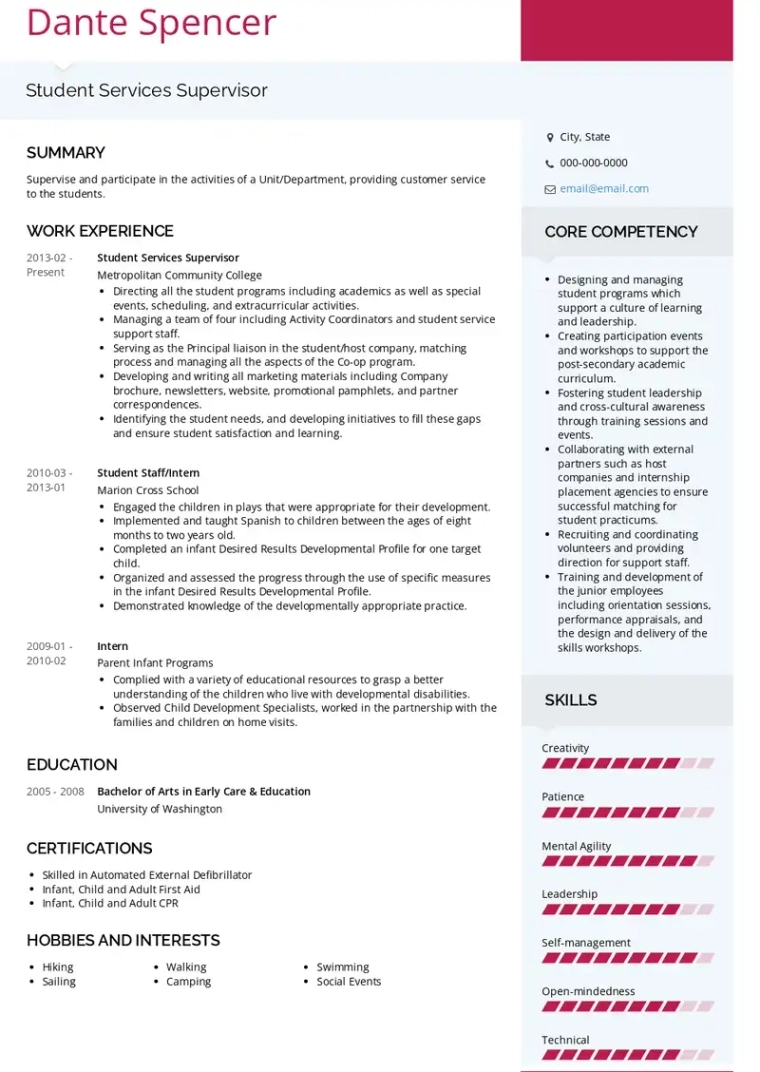
Traditional Student Resume Format Example
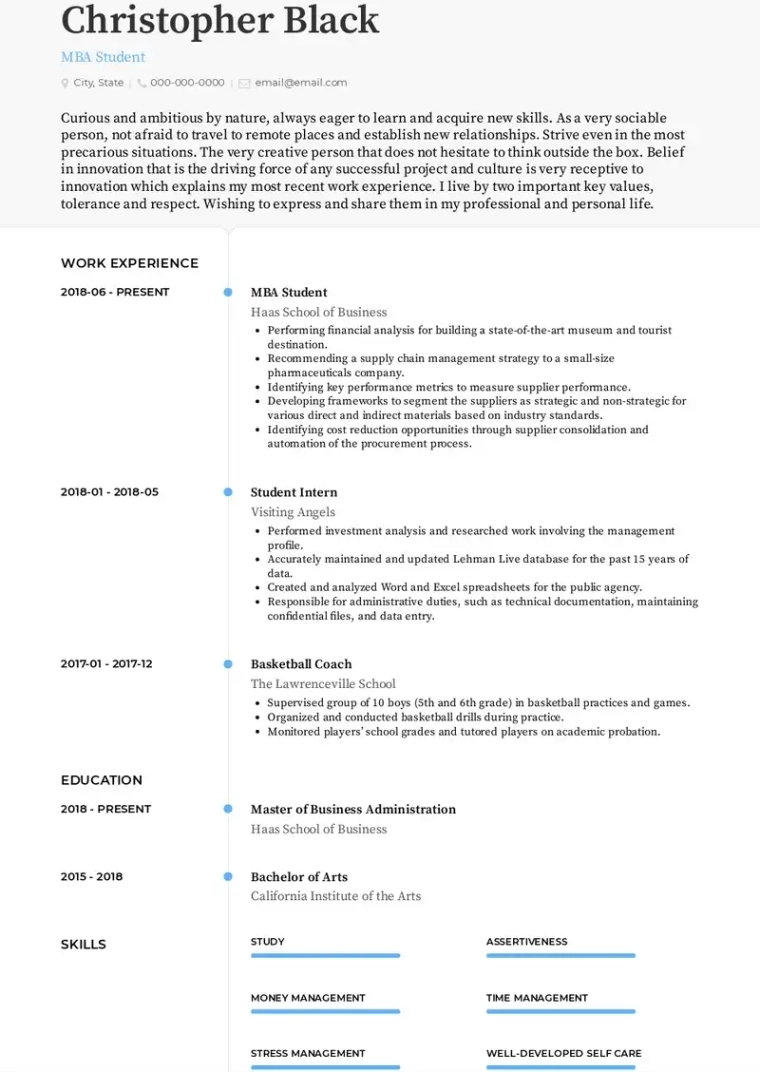
Management Student Resume Format Example
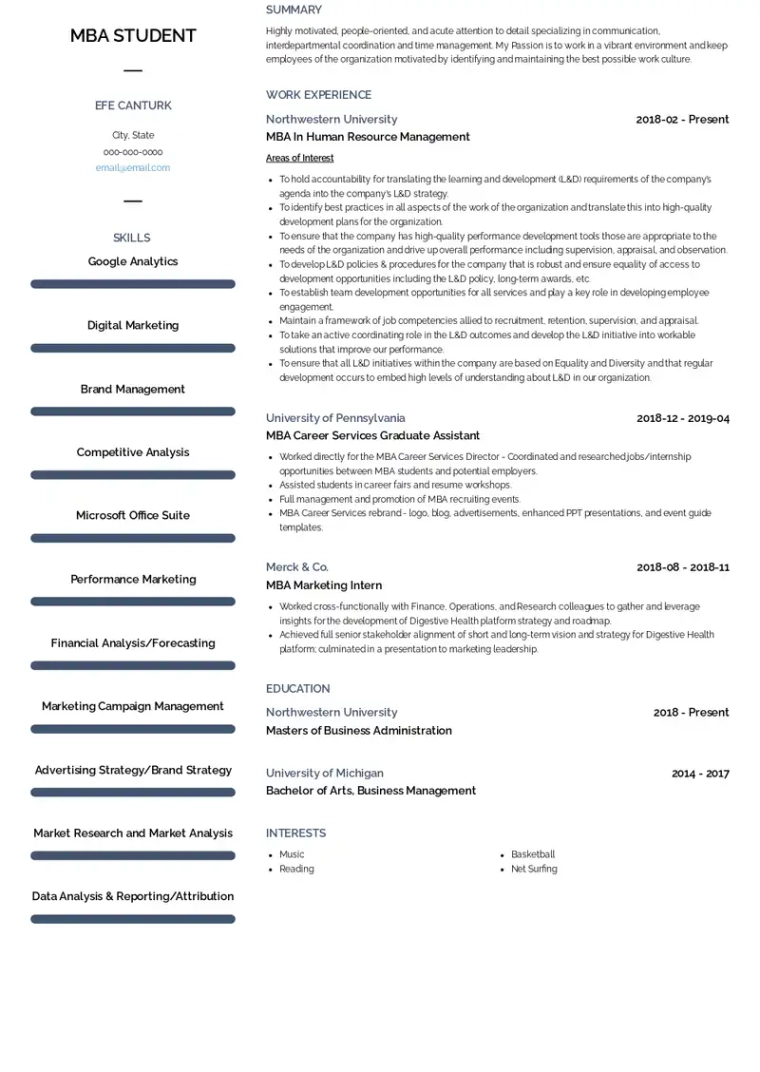
Academic Resume Format Example (PhD)
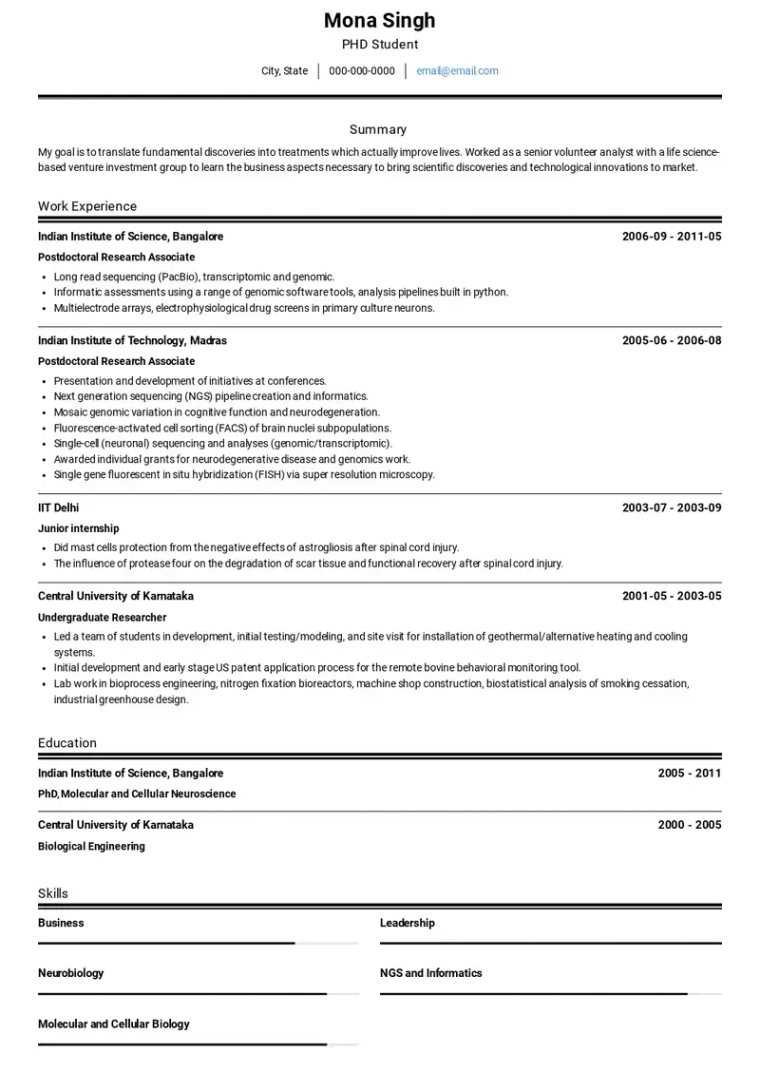
School Student Resume Format Example
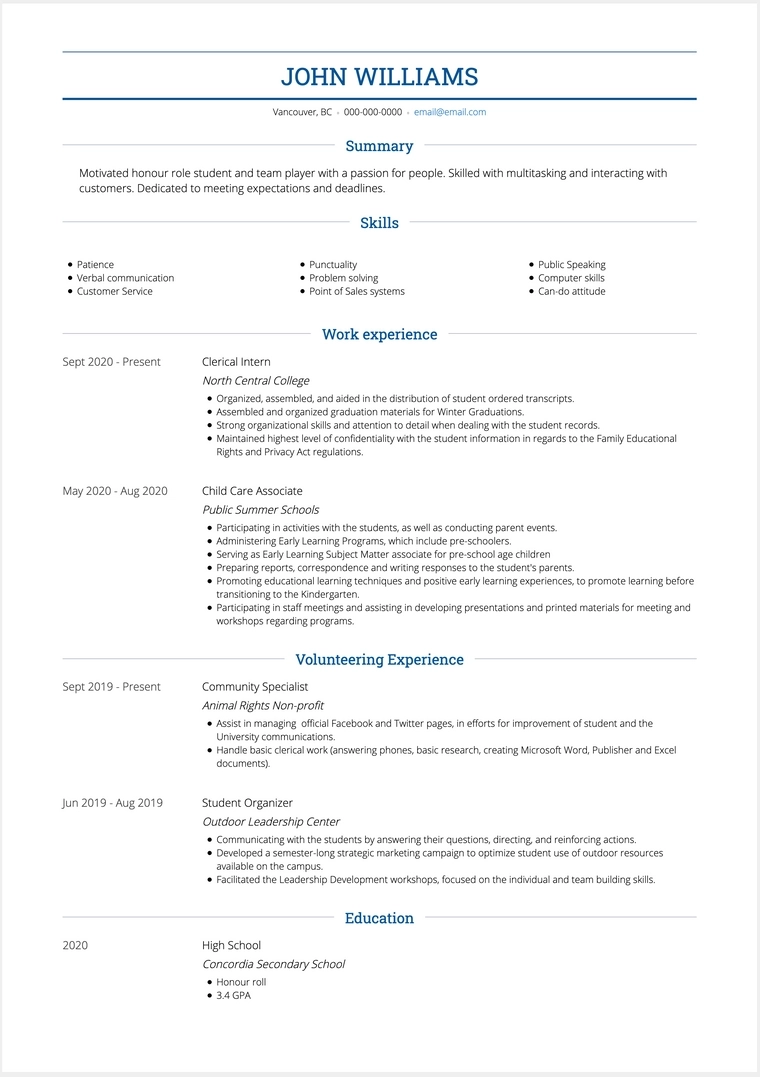
Does the Resume Format Change Every Year?
Resume formats rarely change every year. Over the last 10 years, we see the reverse chronological, functional, and combination resume formats stay popular. They are unlikely to be replaced in 2023 or 2024.
What Format of Resume is Best - PDF or Doc?
See if there’s a format requested by the hiring manager. If there’s no preference, go with the PDF format. However, if a recruiting agency has requested your resume to share with their client, send a word (doc, docx) format as it will be easier for them to anonymize and share.
How to Format a Single Page Resume?
To format a resume that’s only one page, make sure that:
- Your fonts are readable and allow a hiring manager to easily skim through for relevant information. Remember, anything below 11 pt font size is too small to read.
- Make sure your resume doesn’t look too empty. Any resume with less than 50% of the space used would appear incomplete.
- Use a two column resume layout if it is impossible to fit the content within a single column resume layout.
- Use colors wisely. Don’t use more than two colors for text to format your resume.
- You can’t add everything you want to on a single page resume, so we recommend that you customize it for each job application. You’ll be able to provide more information with the same amount of space used.
- Cut down fluff on your resume. Formatting it to be fluff free would help you beat other 90% poorly formatted resumes received by a hiring manager.
How to Format a Two Page Resume?
To format a two page resume, follow these tips:
- If you have relevant experience, go with a reverse chronological format. Format your sections in the following order: header -> summary -> experience -> skills -> certification -> education.
- If you don’t have relevant experience, go with a combination or a function resume format. Make sure that the last page doesn’t look too empty.
- Make sure that your resume is fluff free. Often, we see that candidates would add fluff to their resume’s second page just to fill-up empty space.
- Add your contact details on the second page’s footer so that an HR recruiter won’t have to scroll back at the top to locate it.
- Avoid repeating the same sections or skills.
- If you are printing your resume, avoid double printing on the same page.
How Do You Format the Second Page of a Resume
Make sure that the second page doesn’t look too empty e.g. a 70% empty second page would look poorly formatted to a hiring manager. Add your contact information in the footer of the second page to make it easier for a hiring manager to contact you.
Note - We see job applicants who repeat the same content (e.g. skills) on the second page just to fill the second page. We suggest that you use that space to list something else (e.g. achievements, interests, etc).
Why Do Some Companies Ask for Word Format Resumes
A company is likely to ask for a word format resume if they wish to anonymize your resume and submit it to their clients.
How to Format Resume to Get it All on One Page
To make your resume one page, try the following:
- Prioritize items in the order of impact and relevance to the target job and start adding them to your resume. Remove items that aren’t impactful or relevant and make your resume long.
- Format title fonts and optimize their size so that you can fit everything on one page.
- Reduce your margins as they could add extra length. You shouldn’t reduce the resume margins to less than 1-inch.
- Shorten your bullet points under each job description.
- Limit your summary statement to a maximum of three lines.
- Customize your resume for each job so that it is easy to remove irrelevant skills, certifications, etc and format your resume to one page.
How to Format Header on a 2-Page Resume
To best format a two page resume header do the following:
- Keep your resume header only on the first page. Adding it on top of the second page would break the hiring manager’s readability.
- In your resume header, add the following information - your full name, city, state/province, link to your portfolio or Linkedin, your current or prospective job title.
- To format your two page resume header more, you can test out using different colors for your name or your current job title and see if they stand out.
What Format Should a Resume be in?
A modern resume should be in a PDF format. Unless specified, PDF is the safest format to send your resume. ATS systems also find it easier to parse PDF format resumes.
How to Format 10 Years of Experience on a Resume?
If you have 10 years of experience on a resume, format your resume in a reverse chronological layout. That way, you would be able to show the most relevant experience upfront to a hiring manager.
Resume Format Example for 10 Years of Work Experience
[Add Employer’s name here] Your Job title, MM-YYYY - MM-YYYY
- [ List your roles and responsibilities here - single line, follow the STAR framework]
- [ List your roles and responsibilities here - single line, follow the STAR framework]
- [ List your roles and responsibilities here - single line, follow the STAR framework]
- [ List your roles and responsibilities here - single line, follow the STAR framework]
The resume format example is easy to follow if you had different job titles under different employers. But, what if you had different job titles while working for the same employers?
Perhaps you were promoted. Consider a format that helps you communicate that. Here’s an example format.
Resume Format Example for 10 Years of Work Experience (Multiple Positions, Same Employer)
[Add Employer’s name here] Your last Job title under this employer, MM-YYYY - MM-YYYY
- [ List your roles and responsibilities here - single line, follow the STAR framework]
- [ List your roles and responsibilities here - single line, follow the STAR framework]
- [ List your roles and responsibilities here - single line, follow the STAR framework]
- [ List your roles and responsibilities here - single line, follow the STAR framework]
Your preview Job title under this employer, MM-YYYY - MM-YYYY
- [ List your roles and responsibilities here - single line, follow the STAR framework]
- [ List your roles and responsibilities here - single line, follow the STAR framework]
- [ List your roles and responsibilities here - single line, follow the STAR framework]
- [ List your roles and responsibilities here - single line, follow the STAR framework]
How to Format 20 Years of Experience on a Resume?
To format 20 years of experience on a resume, follow these steps:
- Create an entry for each position you held and use the STAR framework to describe what you did and the impact you made.
- Don’t be afraid to let your experience occupy more space. Remember, it is acceptable to have a two page resume when your work experience is more than 20 years.
- Not all experience can be best communicated or emphasized under the work experience section. Create a highlights/industry expertise/accomplishment section to stand out.
- Use fonts and colors to reflect your personality. Avoid going below 11 pt font size and using font colors that aren’t readable.
- The right format would have the following sections at minimum for: header, summary, work history, skills, certifications, achievements, and education.
Resume Formatting Tips: Margins, Spacing, and Font
Resume formatting is crucial to making a good impression on hiring managers. Here are some tips for formatting a resume:
- Margins: Leave at least 0.5 inches of margin on all sides to make the resume easy to read.
- Spacing: Use a consistent spacing throughout the resume, with at least 1-2 lines of space between sections.
- Font: Use a standard font such as Arial, Calibri or Helvetica, and avoid using fonts that are too ornate or difficult to read.
- Font size: Use a font size between 10-12 points for the body of the resume, and 14-16 points for headings.
Resume Templates and Examples for Different Industries
Resume templates and Resume examples can help job seekers create a professional-looking resume that is tailored to their industry. Here are some examples of resume templates and examples for different industries:
- Engineering: A resume template for engineers should highlight technical skills and experience, with a focus on projects and achievements.
- Nursing: A resume template for nurses should highlight clinical skills and experience, with a focus on patient care and medical procedures.
- IT: A resume template for IT professionals should highlight technical skills and certifications, with a focus on software and hardware experience.
- Understanding Resume Formats
- Why Resume Format is Important?
- How to Format a Professional Resume?
- Choosing the Best Resume Format
- Resume Formatting Checklist
- Resume Formatting Checklist to Show Relevance to the Target Job
- How to Format a Creative Resume?
- Three Popular Resume Formats (with Examples)
- 2024 Resume Format Trends We Observed So Far
- How to Format a Reverse Chronological Resume?
- How to Format a Functional Resume?
- How to Format a Combination Resume?
- How to Format a Messy Resume?
- Formatting a One Year Experience Resume
- 2 Year Experience Resume Format
- 10 Year Experience Resume Format
- Resume Formatting Tips for 15, 20+ Years of Experience
- Resume Format for 50-Year-Olds
- Student and Entry-Level Resume Format Examples
- Does the Resume Format Change Every Year?
- What Format of Resume is Best - PDF or Doc?
- How to Format a Single Page Resume?
- How to Format a Two Page Resume?
- How Do You Format the Second Page of a Resume
- Why Do Some Companies Ask for Word Format Resumes
- How to Format Resume to Get it All on One Page
- How to Format Header on a 2-Page Resume
- What Format Should a Resume be in?
- How to Format 10 Years of Experience on a Resume?
- How to Format 20 Years of Experience on a Resume?
- Resume Formatting Tips: Margins, Spacing, and Font
- Resume Templates and Examples for Different Industries

Written By
Madison Norton
VP Marketing & Resume Expert
Madison is the VP Marketing and General Manager at VisualCV. He's a seasoned marketing leader, resume writing and career marketing expert and now helping people grow their own career marketing strategies to build a career they love.
![The 2025 Resume Writing Guide [+ Job Search Tips and Resume Examples]](/static/0a451b7c20b67c3a0ce6a7b4a7680f5f/61ca5/Resume_Guide.jpg)
The 2025 Resume Writing Guide is filled with quality job search tips, resume examples and information you need to know before writing your resume or CV.
January 3, 2025
Read Post

VP Marketing & Resume Expert

Your technical skills are an important part of what makes you a great candidate. Here's how you should display your technical skills on your resume.
December 14, 2022
Read Post

Community Success Manager & CV Writing Expert

When you decide to take your career in a different direction, it's important to write a great career change resume.
May 4, 2022
Read Post

Community Success Manager & CV Writing Expert
Copyright ©2025 Workstory Inc.